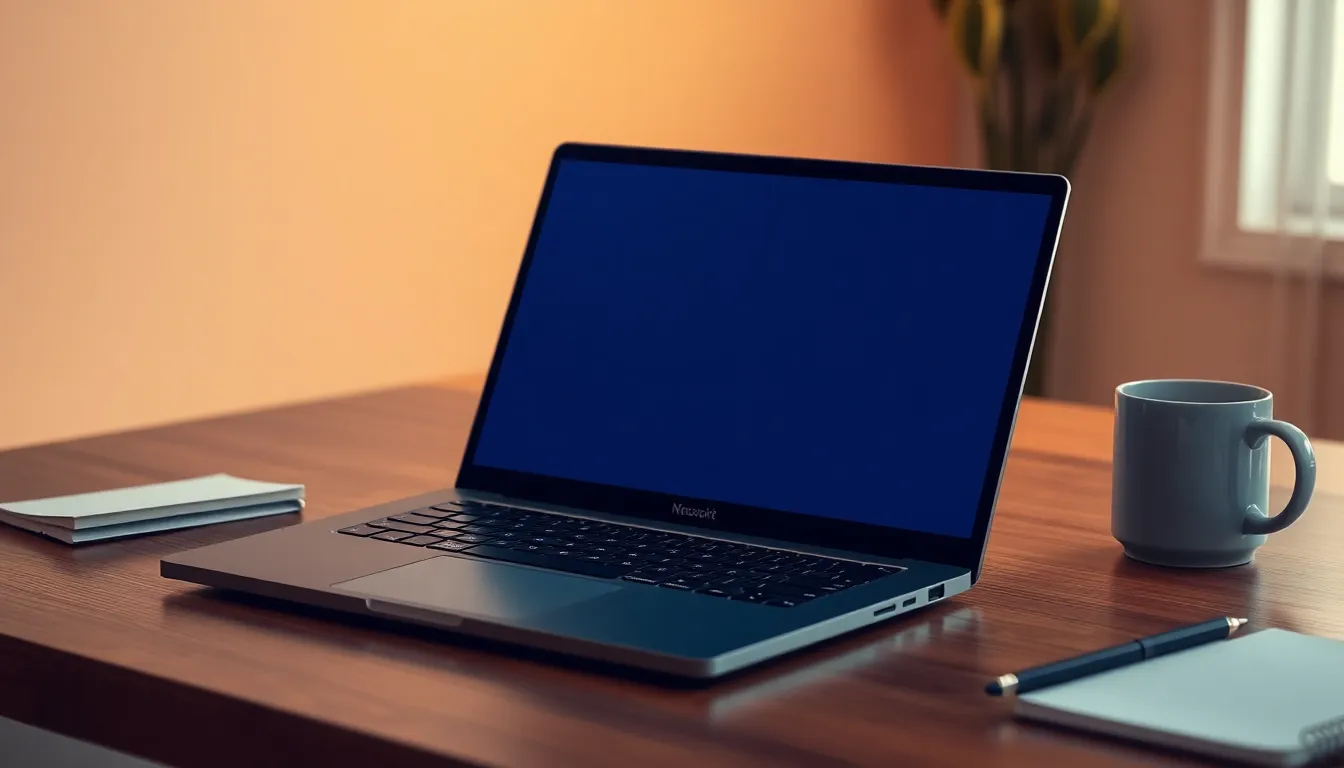In today’s fast-paced tech landscape, touchscreen notebooks have emerged as a game-changer for both professionals and students. Combining the versatility of a tablet with the functionality of a laptop, these devices offer a seamless user experience that caters to various needs. Whether it’s for creative tasks, business presentations, or everyday browsing, touchscreen notebooks provide an intuitive interface that enhances productivity.
As manufacturers innovate and improve their designs, a plethora of models flood the market, each boasting unique features and specifications. From sleek ultrabooks to powerful 2-in-1 devices, the options can be overwhelming. Understanding the key aspects of touchscreen notebooks can help users make informed decisions, ensuring they choose the right model that fits their lifestyle and requirements.
Table of Contents
ToggleOverview of Touchscreen Notebook Models
Touchscreen notebooks blend the functionality of traditional laptops with the responsiveness of tablets, catering to diverse user needs. Multiple models exist, each equipped with distinct features and characteristics.
Key Features of Touchscreen Notebooks
- Display Quality: Many models offer Full HD or 4K resolution, enhancing visuals for multimedia tasks.
- Form Factor: Options range from clamshell designs to 2-in-1 convertibles, enabling flexibility in use.
- Processor Variety: Users can choose from different processors, including Intel Core and AMD Ryzen, affecting performance and speed.
- Battery Life: Battery performance varies significantly, with average usage lasting between 8 to 15 hours depending on the model.
- Stylus Support: Certain models come with stylus compatibility, enhancing precision for note-taking and drawing tasks.
Popular Touchscreen Notebook Models
| Model Name | Type | Screen Size | Resolution | Battery Life |
|---|---|---|---|---|
| Dell XPS 13 | Ultrabook | 13.4 inch | 4K | Up to 12 hours |
| HP Spectre x360 | 2-in-1 | 13.3 inch | Full HD | Up to 10 hours |
| Lenovo Yoga C740 | 2-in-1 | 14 inch | Full HD | Up to 12 hours |
| Microsoft Surface Laptop 4 | Ultrabook | 13.5 inch | 3:2 PixelSense | Up to 11 hours |
| ASUS ZenBook Flip 14 | 2-in-1 | 14 inch | Full HD | Up to 15 hours |
Considerations for Selection
- Usage Requirements: Determine if the primary needs lean toward productivity, entertainment, or creative tasks.
- Portability: Weigh the importance of weight and dimensions for mobility against screen size preferences.
- Budget Constraints: establish a price range to narrow down options, as models can vary from budget to premium segments.
Touchscreen notebook models enhance user experience by combining the advantages of laptops and tablets, with various features tailored to meet specific needs.
Key Features to Consider

Understanding key features of touchscreen notebooks ensures users choose models that fit their needs effectively. Important aspects include display quality, battery life, and performance.
Display Quality
Display quality significantly impacts user experience. Key factors include screen size, resolution, and brightness. Models with Full HD (1920 x 1080) or higher resolutions offer crisp visuals for tasks like graphic design or video editing. Brightness levels of 300 nits or more deliver visibility in various lighting conditions, enhancing usability in outdoor settings. Touchscreen responsiveness is also crucial; capacitive touch displays provide better accuracy and fluidity during use.
Battery Life
Battery life dictates how long a notebook can function without charging. Many models offer around 8 to 12 hours of usage on a single charge. Users engaged in intensive tasks like video rendering may require shorter battery life, while casual users might prioritize longer durations. Fast-charging features can also be beneficial, allowing users to recharge their devices quickly during busy days.
Performance and Specifications
Performance revolves around processor type, RAM, and storage options. High-performance notebooks often feature Intel Core i5 or i7 and AMD Ryzen 5 or 7 processors for seamless multitasking. At least 8 GB of RAM improves efficiency, while 16 GB suits demanding applications. Storage preferences vary; solid-state drives (SSDs) offer faster access speeds compared to traditional hard drives (HDDs), providing quicker boot times and application loading. Users should align specifications with intended use, balancing performance and budget considerations.
Popular Touchscreen Notebook Models
Various touchscreen notebook models cater to diverse preferences and needs. Below are reviews of three prominent models showcasing their unique features and functionalities.
Model A Review
Dell XPS 13
The Dell XPS 13 combines a sleek design with robust performance. It features a 13.4-inch display with options for FHD+ (1920 x 1200) or 4K UHD+ (3840 x 2400) resolutions, providing sharp visuals and vibrant colors. Equipped with Intel Core i5 or i7 processors, 8 GB or 16 GB of RAM, and SSD configurations up to 2 TB, this model excels in multitasking and performance. Battery life averages around 11 hours, making it suitable for lengthy usage. The XPS 13’s UltraSharp display boasts 400 nits of brightness, enhancing outdoor visibility.
Model B Review
HP Spectre x360
The HP Spectre x360 stands out with its premium build and convertible design. It features a 13.3-inch or 15.6-inch touchscreen display available in FHD or 4K resolution. Powered by Intel Core i5 or i7 processors, the Spectre x360 offers up to 16 GB of RAM and up to 1 TB SSD storage. Battery performance reaches approximately 12 hours, allowing users to work uninterrupted throughout the day. The device includes a pop-up privacy camera and Bang & Olufsen audio, delivering superior security and sound quality.
Model C Review
Lenovo Yoga C740
The Lenovo Yoga C740 is a versatile 2-in-1 touchscreen notebook known for its flexibility and affordability. With a 14-inch FHD display, it offers an immersive viewing experience, supporting stylus input for creative tasks. This model features Intel Core i5 or i7 processors with up to 12 GB of RAM and SSD options up to 512 GB. Battery life lasts around 10 hours, beneficial for on-the-go users. The Yoga C740’s Yoga Mode enables easy transitions between laptop and tablet modes, ideal for presentations and media consumption.
Pros and Cons of Touchscreen Notebooks
Touchscreen notebooks offer distinct advantages and disadvantages that users should consider before making a purchase.
Pros
- Intuitive Interaction: Touchscreen notebooks enable direct interaction with applications, making navigation simpler and more engaging.
- Versatility: 2-in-1 models provide both laptop and tablet functionalities, catering to diverse usage scenarios.
- Enhanced Creativity: Many models support stylus input, facilitating drawing, note-taking, and creative endeavors with greater precision.
- Compact Design: Touchscreen notebooks often feature thinner, lighter designs, enhancing portability for users on the go.
- Easier Collaboration: The ability to directly touch and manipulate content encourages collaborative work during presentations and group projects.
Cons
- Price Point: Touchscreen notebooks typically cost more than traditional laptops, which can be a consideration for budget-conscious consumers.
- Battery Drain: Touchscreen functionality can lead to decreased battery life, with some models averaging around 8 to 10 hours of usage.
- Fingerprint Smudges: Touchscreen surfaces are prone to fingerprints and smudges, potentially requiring frequent cleaning to maintain clarity.
- Weight Distribution: Some models can feel heavier or unbalanced when used in tablet mode, affecting comfort during extended use.
- Screen Glare: Glossy touchscreens may reflect light, reducing visibility in bright environments and affecting the overall viewing experience.
Evaluating these pros and cons helps users determine if touchscreen notebooks align with their specific needs and preferences.
Touchscreen notebooks represent a significant advancement in personal computing. Their blend of portability and functionality caters to a diverse range of users from students to professionals. With options like the Dell XPS 13 and HP Spectre x360, these devices offer impressive features that enhance productivity and creativity.
The decision to invest in a touchscreen notebook should be guided by individual needs and preferences. By considering key factors such as display quality, battery life, and performance specifications, users can find the perfect model that suits their lifestyle. As technology continues to evolve, touchscreen notebooks will likely remain a popular choice for those seeking versatility and ease of use.


